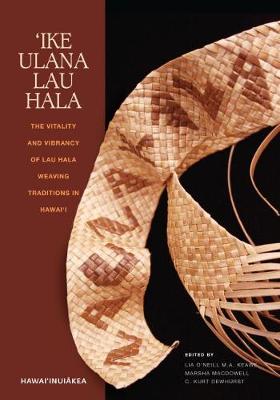Hawai'inuiakea
1 total work
`Ike Ulana Lau Hala
by Lia O'Neill Keawe, Marsha MacDowell, and C Kurt Dewhurst
Published 30 August 2014
The weaving of lau hala represents a living tradition borne on the great arc of Pacific voyaging history. This thriving tradition is made immediate by masters of the art who transmit their knowledge to those who are similarly devoted to, and delighted by, the smoothness, softness, and that particular warm fragrance of a woven lau hala treasure. The third volume in the Hawai'inuiākea series,?Ike Ulana Lau Hala is an intriguing collection of articles and images about the Hawaiian tradition of ulana lau hala: the weaving, by hand, of dried Pandanus tectorius leaves.
`Ike Ulana Lau Hala considers the humble hala leaf through several, very different lenses: an analysis of lau hala items that occur in historic photographs from the Bishop Museum collections; the ecological history on hala in Hawai'i and the Pacific including serious challenges to its survival and strategies to prevent its extinction; perspectives–in Hawaiian–of a native speaker from Ni'ihau on master weavers and the relationship between teacher and learner; a review–also in Hawaiian– of references to lau hala in poetical sayings and idioms; a survey of lau hala in Hawaiian cultural heritage and the documentation project underway to share the art with a broader audience; and a conversation with a master artisan known for his distinct and intricate construction of the lei hala. Rich with imagery, this extraordinary volume will guide the reader to a better understanding of the cultural scope and importance of lau hala, fostering an appreciation of the level of excellence to which the art of ulana lau hala has risen under the guidance of masters who continue to steer the Hawaiian form of the tradition into the future.
`Ike Ulana Lau Hala considers the humble hala leaf through several, very different lenses: an analysis of lau hala items that occur in historic photographs from the Bishop Museum collections; the ecological history on hala in Hawai'i and the Pacific including serious challenges to its survival and strategies to prevent its extinction; perspectives–in Hawaiian–of a native speaker from Ni'ihau on master weavers and the relationship between teacher and learner; a review–also in Hawaiian– of references to lau hala in poetical sayings and idioms; a survey of lau hala in Hawaiian cultural heritage and the documentation project underway to share the art with a broader audience; and a conversation with a master artisan known for his distinct and intricate construction of the lei hala. Rich with imagery, this extraordinary volume will guide the reader to a better understanding of the cultural scope and importance of lau hala, fostering an appreciation of the level of excellence to which the art of ulana lau hala has risen under the guidance of masters who continue to steer the Hawaiian form of the tradition into the future.
